Key Takeaways
- Discover the top 11 creative management software of 2025 with detailed feature comparisons, pricing, and performance insights.
- Learn how leading platforms enhance collaboration, automate workflows, and boost creative productivity across industries.
- Understand key market trends shaping the future of creative management, including AI integration and data-driven optimization.
In 2025, the digital marketing and advertising landscape has reached an unprecedented level of complexity, with creative teams under constant pressure to deliver engaging, high-quality content faster than ever before. From multinational corporations launching multi-channel global campaigns to small businesses striving to maintain a consistent online presence, the demand for efficient, collaborative, and data-driven creative processes has never been greater. This growing need has placed Creative Management Software (CMS) at the heart of modern marketing operations, acting as the central hub for managing creative workflows, digital assets, and campaign execution.

Creative Management Software is far more than just a project management tool. It is a strategic platform designed to streamline the entire creative lifecycle—from brainstorming and asset creation to feedback, approvals, and deployment. In 2025, the most advanced CMS platforms integrate seamlessly with other essential marketing technologies, such as Customer Relationship Management (CRM) systems, Digital Asset Management (DAM) platforms, and advertising networks, ensuring that creative output is both brand-consistent and performance-optimized. These systems also harness the power of Artificial Intelligence (AI) to automate repetitive tasks, predict campaign performance, and deliver personalized creative content at scale.
The competitive nature of today’s marketing environment demands that brands not only produce compelling visuals and messages but also adapt quickly to market shifts, consumer trends, and platform changes. Creative Management Software enables this agility by centralizing communication, reducing production bottlenecks, and providing robust performance insights through analytics dashboards. With features such as dynamic creative optimization, real-time collaboration, automated version control, and advanced asset tagging, CMS platforms allow marketing teams to focus on creativity rather than administrative burdens.
The year 2025 also marks a period of significant transformation in the CMS market. AI-driven innovations are enabling faster content generation and automated design suggestions, while advanced integrations make it possible to synchronize creative assets across multiple platforms instantly. Data analytics is becoming more sophisticated, providing granular insights into the effectiveness of each creative asset and guiding future content strategies. At the same time, emerging technologies such as blockchain are beginning to influence digital asset management, offering greater transparency and security in creative workflows.
In this in-depth analysis of the Top 11 Creative Management Software in 2025, we will explore the leading solutions shaping the industry, comparing their pricing, features, integrations, ease of use, and suitability for different types of businesses. Whether you are a startup looking for a cost-effective, easy-to-use tool or an enterprise seeking a comprehensive platform with advanced automation and scalability, this guide will provide the insights you need to make an informed decision. Through detailed comparisons, case studies, and expert observations, we will uncover how these tools can transform creative processes, maximize productivity, and deliver measurable returns on investment.
By the end of this analysis, readers will have a clear understanding of the strengths and limitations of each platform, the key trends influencing the future of creative management, and practical guidance on selecting the software that best aligns with their organization’s goals. In a world where speed, efficiency, and creativity determine market success, investing in the right CMS is no longer optional—it is a competitive necessity.
Before we venture further into this article, we would like to share who we are and what we do.
About 9cv9
9cv9 is a business tech startup based in Singapore and Asia, with a strong presence all over the world.
With over nine years of startup and business experience, and being highly involved in connecting with thousands of companies and startups, the 9cv9 team has listed some important learning points in this overview of The Top 11 Creative Management Software in 2025: An In-Depth Analysis.
If your company needs recruitment and headhunting services to hire top-quality employees, you can use 9cv9 headhunting and recruitment services to hire top talents and candidates. Find out more here, or send over an email to [email protected].
Or just post 1 free job posting here at 9cv9 Hiring Portal in under 10 minutes.
Top 11 Creative Management Software in 2025: An In-Depth Analysis
1. AdCreative.ai
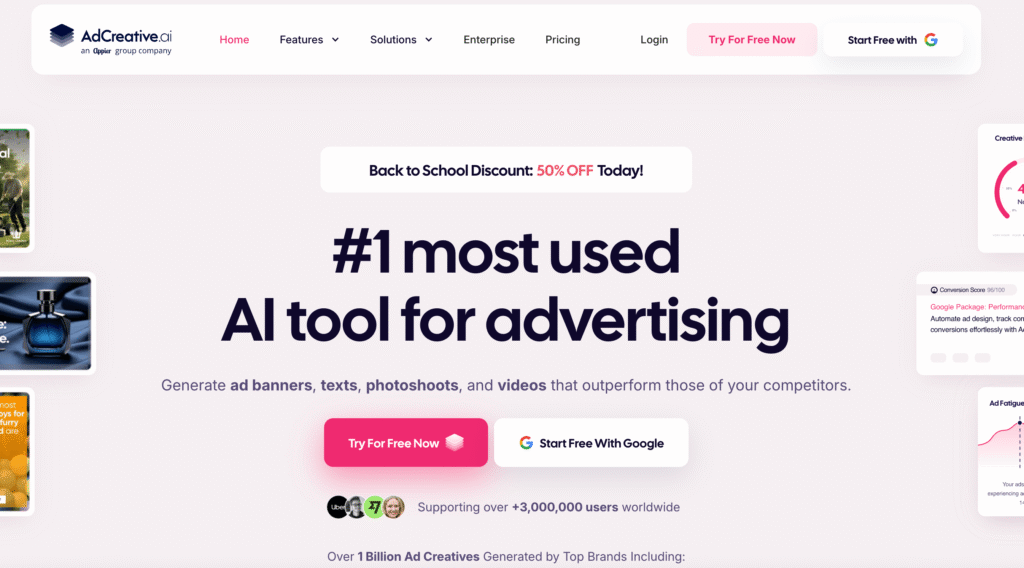
Overview of AdCreative.ai
- AdCreative.ai is a leading AI-driven platform engineered to produce high-performing digital advertising creatives across multiple online channels.
- Its core mission revolves around streamlining the ad creation process while simultaneously enhancing engagement and conversion rates through intelligent automation.
- Positioned as one of the top Creative Management Software solutions for 2025, the platform appeals to a diverse audience, particularly small businesses seeking scalable ad solutions.
Quantitative Performance Metrics
- G2 Rating: 4.3/5 based on 773 user reviews.
- TrustRadius Score: 8.9/10 based on 5 user reviews.
- Market Recognition: Designated as a “Top Performer” on Capterra.
- User Demographics: Approximately 91% of the platform’s clientele are small businesses.
- Pricing Structure: Subscription begins at $29 per month.
- Conversion Efficiency: Claims indicate ad creatives generated via the platform can achieve up to 14 times higher conversion rates compared to conventional methods.
- Affiliate Incentives: Offers a 30% recurring commission per paid sign-up.
- Strategic Acquisition: Appier acquired AdCreative.ai for $38.7 million, reflecting strong market valuation and growth potential.
Key Features and Capabilities
- AI-Powered Ad Generation: Rapid creation of numerous ad variations with minimal manual intervention.
- Dynamic Creative Optimization: Tailors ads for optimal engagement across different platforms.
- Performance Prediction: Analytical insights to identify the most promising creatives prior to campaign launch.
- Brand Consistency Verification: Ensures all creatives adhere to brand guidelines, maintaining uniform messaging.
- A/B Testing Integration: Facilitates campaign optimization by testing multiple ad versions and analyzing performance outcomes.
User Experience Insights
- Ease of Use: Users consistently highlight its intuitive interface, allowing seamless operation even for non-designers.
- Campaign Efficiency: Recognized for significantly reducing the time and effort required to generate visual content for advertising campaigns.
- Creative Diversity: Enables users to produce a wide variety of ad creatives quickly, supporting experimentation and campaign agility.
- Strategic Impact: Enhances campaign testing and decision-making, improving overall marketing ROI.
Market Position and Strategic Insights
- AI-Centric Approach: AdCreative.ai exemplifies the growing trend of leveraging artificial intelligence to optimize advertising workflows and results.
- Accessibility: Its user-friendly design empowers small businesses and non-design professionals to create high-quality ad content without extensive design knowledge.
- Growth Trajectory: The acquisition by Appier positions the platform for integration into a broader marketing technology ecosystem, potentially enhancing its capabilities and reach.
- Pricing Consideration: While competitively priced, startups with highly constrained budgets may need to assess cost-effectiveness relative to expected ROI.
Comparative Overview (Sample Matrix)
| Feature | AdCreative.ai Value | Competitor Average | Advantage/Impact |
|---|---|---|---|
| Conversion Rate Improvement | Up to 14x higher | 3-5x | Significant uplift in ad effectiveness |
| Ease of Use | High, intuitive interface | Medium | Low learning curve for new users |
| Brand Consistency | Automated verification | Manual or semi-automated | Ensures unified brand messaging |
| Pricing | Starting at $29/month | $50-$100/month | Cost-efficient for SMBs |
| AI-Powered Creative Generation | Fully automated ad variations | Partial automation | High-speed creative production |
Conclusion
AdCreative.ai firmly establishes itself as a premier Creative Management Software in 2025, excelling in automation, AI-driven optimization, and accessibility. Its proven ability to drive higher conversions, coupled with a strategic acquisition by Appier, underscores its growing influence and market credibility. Small businesses and marketers seeking a balance of innovation, efficiency, and ROI-focused advertising will find AdCreative.ai a formidable asset for their campaigns.
2. Bynder
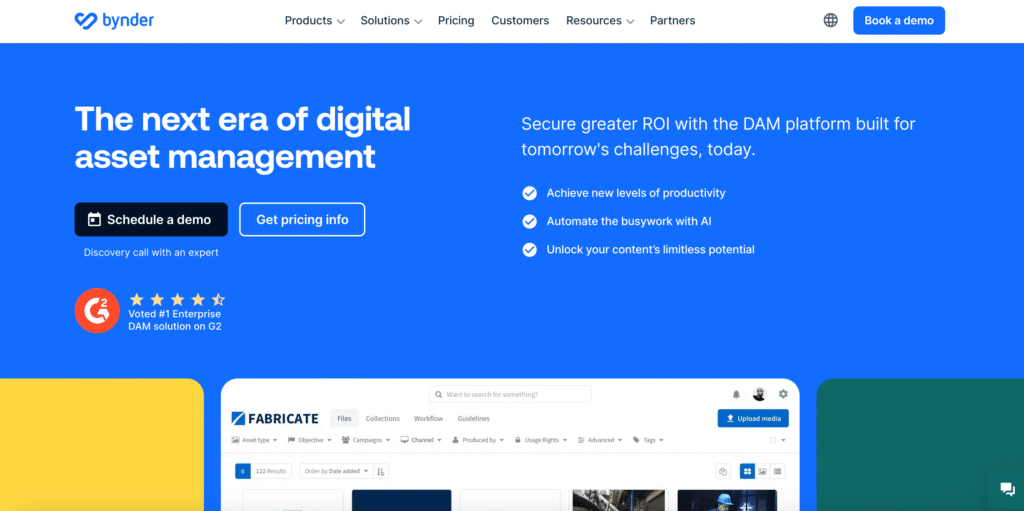
Overview of Bynder
- Bynder is recognized as a premier digital asset management (DAM) platform, designed to address the complexities of managing digital content across multiple channels.
- Beyond traditional DAM capabilities, it integrates advanced creative project management functionalities, enabling brands to streamline content workflows and maintain brand consistency.
- Bynder’s position among the top Creative Management Software in 2025 is reinforced by its enterprise-grade capabilities, extensive user adoption, and industry recognition.
Quantitative Performance Metrics
- G2 Rating: 4.5 out of 5 stars based on 954 reviews.
- Capterra Rating: 4.4 out of 5 stars.
- TrustRadius Score: 7.1 out of 10.
- Global Reach: Over 1.7 million users and more than 4,000 brands rely on Bynder for digital asset management.
- Pricing Structure: Starting at approximately $450 per month, positioning it as an enterprise-focused solution.
- Revenue & Valuation: Achieved €100 million in annual recurring revenue, with a market valuation of $600 million as of December 2022.
- Market Share: Commands around 0.5% of the Digital Asset Management market.
Key Features and Functionalities
- Comprehensive Digital Asset Management: Centralizes, organizes, and categorizes digital media assets to enhance discoverability and operational efficiency.
- Brand Management Tools: Ensures consistent application of brand guidelines across all creative assets and marketing campaigns.
- Workflow Automation: Streamlines creative processes, reducing manual tasks and accelerating project completion timelines.
- AI-Powered Search: Facilitates rapid asset discovery, enabling teams to locate the right resources efficiently.
- Real-Time Collaboration: Provides collaborative workspaces for teams to edit, review, and approve assets in real time.
User Experience Insights
- Ease of Use: Users consistently highlight its intuitive interface and adaptability to varied creative workflows.
- Asset Organization: Praised for its ability to maintain high asset discoverability while supporting complex organizational structures.
- Onboarding & Support: Positive user feedback regarding onboarding processes and customer support reinforces its enterprise reliability.
- Creative Workflow Efficiency: Enables teams to optimize productivity and maintain consistency across campaigns, even at scale.
Strategic Market Position
- Enterprise-Focused Solution: Bynder’s pricing and capabilities cater primarily to large organizations requiring robust DAM and creative project management integration.
- Established Credibility: Its adoption by thousands of brands and over a million users demonstrates reliability and market trust.
- Integrated Workflow Advantage: By combining DAM with creative management features, Bynder reduces friction between asset storage and campaign execution.
- Market Significance: Its €100 million ARR and $600 million valuation reflect strong financial health and industry influence.
Comparative Overview (Sample Matrix)
| Feature | Bynder Value | Competitor Average | Advantage/Impact |
|---|---|---|---|
| User Base | 1.7M+ users, 4,000+ brands | 500K-1M users | Wide adoption ensures ecosystem stability |
| Ease of Use | High, adaptable interface | Medium | Reduces learning curve for teams |
| Workflow Automation | Full automation capabilities | Partial automation | Enhances productivity and efficiency |
| AI-Powered Search | Advanced search for rapid asset discovery | Basic search | Saves time and optimizes operations |
| Pricing | Starting at $450/month | $100-$300/month | Enterprise-grade investment |
Conclusion
Bynder solidifies its position as a top-tier Creative Management Software in 2025 by seamlessly integrating digital asset management with creative workflow capabilities. Its extensive feature set, strong market adoption, and enterprise-grade reliability make it an ideal solution for large organizations seeking efficiency, brand consistency, and team collaboration. Bynder’s robust performance metrics and user satisfaction underline its effectiveness in transforming the management of digital assets and creative projects at scale.
3. Ziflow
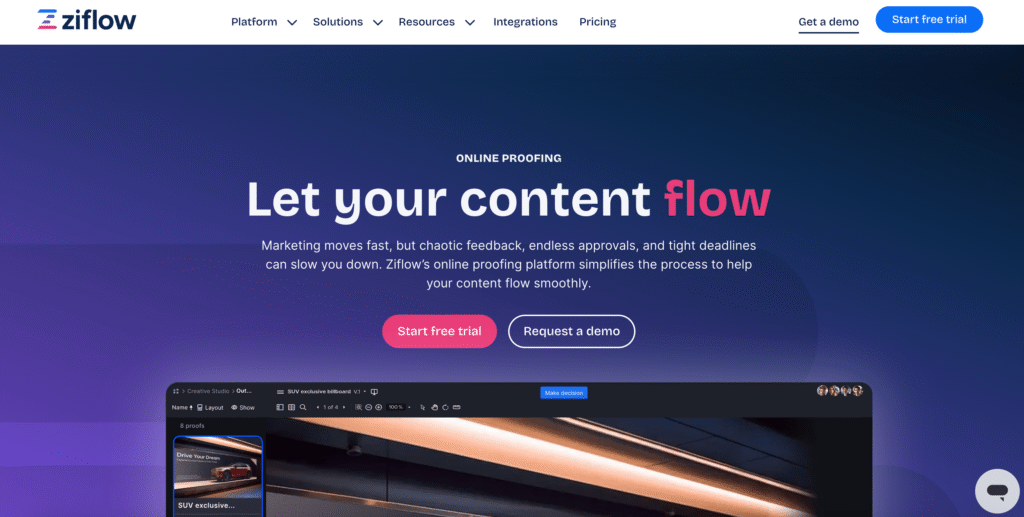
Overview of Ziflow
- Ziflow is an industry-leading online proofing and creative workflow platform designed to optimize the review and approval processes of diverse creative assets.
- By centralizing feedback and streamlining collaboration, Ziflow significantly accelerates the delivery of high-quality creative content.
- Its specialization in creative review workflows positions it as one of the top Creative Management Software solutions in 2025, especially for organizations that prioritize efficiency, compliance, and cross-functional collaboration.
Quantitative Performance Metrics
- G2 Rating: 4.5 out of 5 stars based on 917 user reviews.
- TrustRadius Score: 9.3 out of 10 from 253 reviews, reflecting exceptional user satisfaction.
- Market Recognition: Ranked above comparable online proofing solutions on multiple review platforms.
- Pricing Structure: Standard team plan starts at $199 per month, targeting small to medium-sized teams.
- Accessibility: Offers a free plan for individual users, extending its usability to freelance professionals and smaller creative teams.
Key Features and Functionalities
- Online Proofing: Supports over 1,200 file types, enabling teams to review diverse creative content efficiently.
- Automated Workflows: Customizable review and approval stages streamline the creative lifecycle and minimize bottlenecks.
- Version Control: Robust tracking system allows teams to monitor changes, compare iterations, and maintain asset integrity.
- Collaborative Annotations: Provides tools for direct asset annotations, enhancing clarity and actionable feedback.
- AI-Powered Enhancements: Features such as copy suggestions and compliance checks ensure quality, consistency, and adherence to regulatory standards.
User Experience Insights
- Single Source of Truth: Users report that Ziflow centralizes feedback, preventing fragmented communication and ensuring clarity in decision-making.
- Ease of Feedback: The platform simplifies commenting and collaborative interactions, making the review process more intuitive.
- Cross-Functional Collaboration: Recognized as a strong enabler of collaboration between design, marketing, and regulatory teams.
- Efficiency Gains: High user ratings indicate measurable improvements in review speed and overall workflow efficiency.
Strategic Market Position
- Workflow Specialization: Ziflow focuses on the critical stages of creative review and approval, differentiating itself from general-purpose creative management tools.
- Compliance Emphasis: Its regulatory and compliance tools make it highly relevant for industries such as finance, healthcare, and legal services.
- Scalability: Offers plans suitable for individual users, small teams, and larger organizations, making it versatile across organizational sizes.
- Market Credibility: Strong ratings across G2 and TrustRadius demonstrate user trust and platform reliability.
Comparative Overview (Sample Matrix)
| Feature | Ziflow Value | Competitor Average | Advantage/Impact |
|---|---|---|---|
| File Type Support | 1,200+ file formats | 500-800 | Handles diverse asset types seamlessly |
| Workflow Automation | Fully customizable review stages | Partial automation | Reduces bottlenecks and speeds delivery |
| Version Control | Robust iteration tracking | Basic version tracking | Maintains asset integrity and auditability |
| Collaboration Tools | Real-time annotations and feedback | Limited annotation | Enhances cross-team efficiency |
| AI Features | Copy suggestions, compliance checks | Minimal AI support | Ensures quality and regulatory adherence |
Conclusion
Ziflow establishes itself as a top Creative Management Software in 2025 by specializing in the review and approval stage of creative workflows. Its robust feature set, including AI-powered compliance tools, extensive file support, and collaborative capabilities, addresses the unique needs of organizations seeking efficiency and precision. High user ratings, flexible accessibility, and a strong focus on compliance position Ziflow as an indispensable solution for teams aiming to streamline creative processes while maintaining quality and accountability.
4. Bannerflow
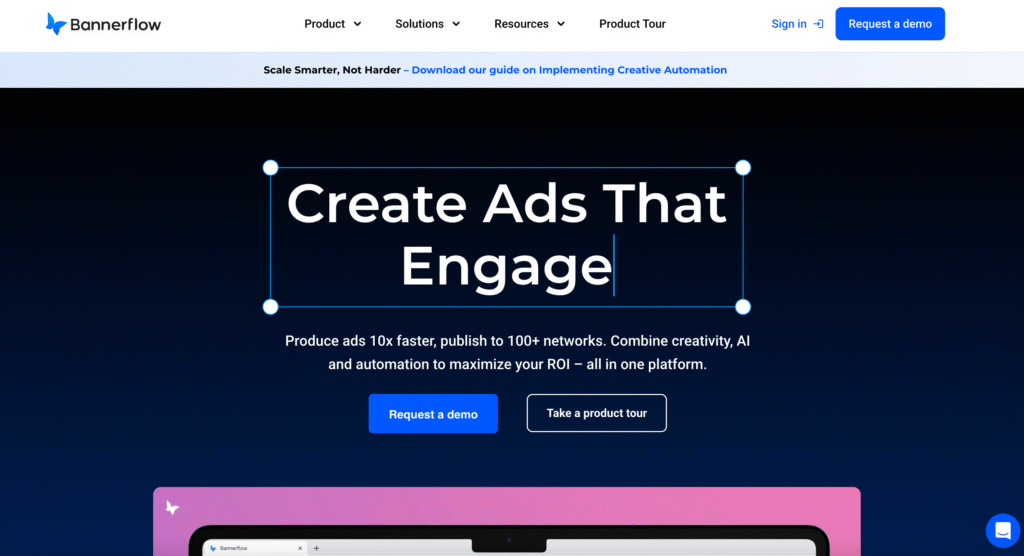
Overview of Bannerflow
- Bannerflow is a specialized Creative Management Platform (CMP) tailored for managing digital display and social media advertising campaigns.
- The platform is engineered to simplify the creation, deployment, and optimization of digital ads, enabling marketing teams to execute campaigns efficiently across multiple channels.
- Recognized as one of the top Creative Management Software solutions in 2025, Bannerflow combines intuitive design, automation, and analytics to deliver high-performing campaigns.
Quantitative Performance Metrics
- G2 Rating: 4.6 out of 5 stars based on 153 user reviews.
- Ease of Use Ranking: Positioned 10th among creative management platforms for user-friendliness.
- Target Audience: Predominantly mid-market companies (46%) and enterprise organizations (28%).
- Accessibility: Offers a 14-day free trial to allow potential users to evaluate platform capabilities.
- Campaign Scale: Optimized for large-scale advertising operations, including multi-language and multi-platform campaigns.
Key Features and Functionalities
- Drag-and-Drop Ad Editor: Intuitive interface enables marketers to create complex ad creatives without coding knowledge.
- Automated Ad Resizing: Dynamically adjusts creatives to meet specifications across diverse platforms and ad formats.
- Campaign Management Tools: Provides end-to-end oversight of the advertising lifecycle, from creation to optimization.
- Ad Personalization: Delivers targeted messaging to specific audiences for improved engagement and conversion rates.
- Real-Time Reporting and Analytics: Tracks performance metrics, enabling data-driven decisions and campaign optimization.
User Experience Insights
- Campaign Oversight: Users highlight Bannerflow’s ability to manage the entire campaign lifecycle, including multiple languages, formats, and markets.
- Ease of Use: The drag-and-drop editor and pre-built templates are consistently praised for simplifying creative processes.
- Productivity Enhancement: Marketing teams benefit from reduced manual work, accelerated campaign deployment, and more efficient cross-channel management.
- Customer Support: Recognized for responsive support and assistance in onboarding, enhancing overall platform adoption and satisfaction.
Strategic Market Position
- Digital Ad Optimization: Bannerflow’s focus on simplifying complex ad workflows positions it as a preferred solution for enterprises running extensive campaigns.
- Scalability: Well-suited for mid-market and enterprise organizations managing large-scale, multi-channel advertising efforts.
- Workflow Efficiency: Automates repetitive tasks and standardizes ad creation processes, improving operational efficiency.
- Market Credibility: High G2 rating and strong user feedback underscore its effectiveness and reliability in managing digital advertising at scale.
Comparative Overview (Sample Matrix)
| Feature | Bannerflow Value | Competitor Average | Advantage/Impact |
|---|---|---|---|
| Ease of Use | Drag-and-drop editor, pre-built templates | Medium | Low learning curve, faster adoption |
| Ad Resizing Automation | Fully automated across platforms and formats | Partial automation | Saves time, ensures consistency |
| Campaign Management | End-to-end lifecycle oversight | Limited management | Centralized workflow control |
| Personalization | Targeted messaging capabilities | Basic personalization | Higher engagement and conversion |
| Analytics | Real-time performance tracking | Delayed reporting | Data-driven decision-making |
Conclusion
Bannerflow emerges as a top-tier Creative Management Software in 2025 by combining usability, automation, and analytics in a single platform. Its drag-and-drop editor, automated ad resizing, and end-to-end campaign management empower marketing teams to create, manage, and optimize digital ads efficiently. Particularly effective for mid-market and enterprise organizations, Bannerflow ensures scalability, consistency, and measurable campaign performance across multiple channels, reinforcing its reputation as an essential tool for modern digital advertising operations.
5. Celtra
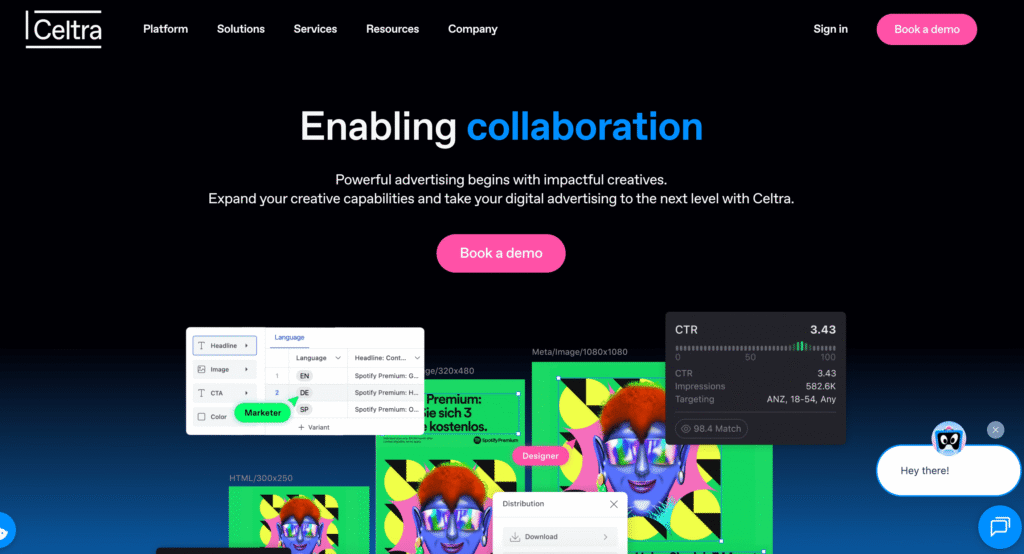
Overview of Celtra
- Celtra is a leading platform in creative automation, designed to revolutionize media advertising through AI-driven production and performance optimization.
- The platform integrates advanced automation capabilities with creative flexibility, allowing brands to deliver high-quality ads at scale across multiple formats and channels.
- Recognized as one of the top Creative Management Software solutions in 2025, Celtra balances operational efficiency with creative expression, catering to businesses seeking both productivity and innovation in digital advertising.
Quantitative Performance Metrics
- G2 Rating: 4.4 out of 5 stars based on 392 user reviews.
- User Demographics: Primarily mid-market companies (46%) and small businesses (32%), reflecting its accessibility to a wide range of organizations.
- Pricing Structure: Customized pricing available upon request, enabling flexibility based on business scale and campaign requirements.
- Multi-Device Reach: Ensures ads are optimized for effectiveness across desktops, mobile devices, and other screens, enhancing campaign impact.
Key Features and Functionalities
- Creative Automation: Automates repetitive production tasks to accelerate ad creation without compromising quality.
- Multi-Format Ad Creation: Supports the development of ads across diverse digital formats, including display, social media, and video.
- Campaign Management Tools: Provides oversight and control over the full lifecycle of advertising campaigns.
- Data-Driven Optimization: Leverages AI and analytics to continuously enhance ad performance and audience targeting.
- Multi-Screen Compatibility: Ensures consistency and effectiveness of campaigns across desktops, mobile devices, and other digital platforms.
User Experience Insights
- Enhanced Creative Freedom: Users consistently praise Celtra’s capacity for customization, allowing campaigns to maintain a unique brand identity while benefiting from automation.
- Performance Optimization: AI-driven insights improve targeting, engagement, and conversion outcomes across campaigns.
- Efficiency Gains: Automation of production processes reduces manual workload, allowing marketing teams to focus on strategy and innovation.
- Versatility Across Business Sizes: Serves mid-market and small enterprises, providing scalability without sacrificing creative quality.
Strategic Market Position
- AI-Driven Creative Automation: Celtra differentiates itself through intelligent automation, streamlining production while optimizing ad performance.
- Balanced Approach: Combines operational efficiency with creative flexibility, making it suitable for marketers seeking both scale and innovation.
- Market Adaptability: Customizable pricing and multi-format support position Celtra as a versatile solution for organizations of varying sizes.
- Proven Effectiveness: Positive user feedback highlights its reliability in delivering high-quality creative assets while enhancing campaign ROI.
Comparative Overview (Sample Matrix)
| Feature | Celtra Value | Competitor Average | Advantage/Impact |
|---|---|---|---|
| Creative Automation | Fully automated production workflows | Partial automation | Reduces manual effort, accelerates delivery |
| Multi-Format Support | Display, social, video ads | Limited formats | Expands reach across channels |
| Campaign Management | End-to-end lifecycle oversight | Basic management | Centralized control for teams |
| AI Optimization | Data-driven performance enhancement | Minimal AI integration | Maximizes engagement and conversions |
| Multi-Screen Compatibility | Ensures cross-device effectiveness | Single device focus | Consistent brand messaging |
Conclusion
Celtra firmly establishes itself as a top Creative Management Software in 2025 by combining AI-powered automation, creative flexibility, and multi-format capabilities. Its strengths in automating production workflows while maintaining creative freedom make it an indispensable tool for mid-market and small businesses aiming to scale digital advertising efficiently. Positive user feedback, extensive functionality, and data-driven optimization underline Celtra’s effectiveness in enhancing campaign performance while preserving the integrity and uniqueness of creative content.
6. Airtory
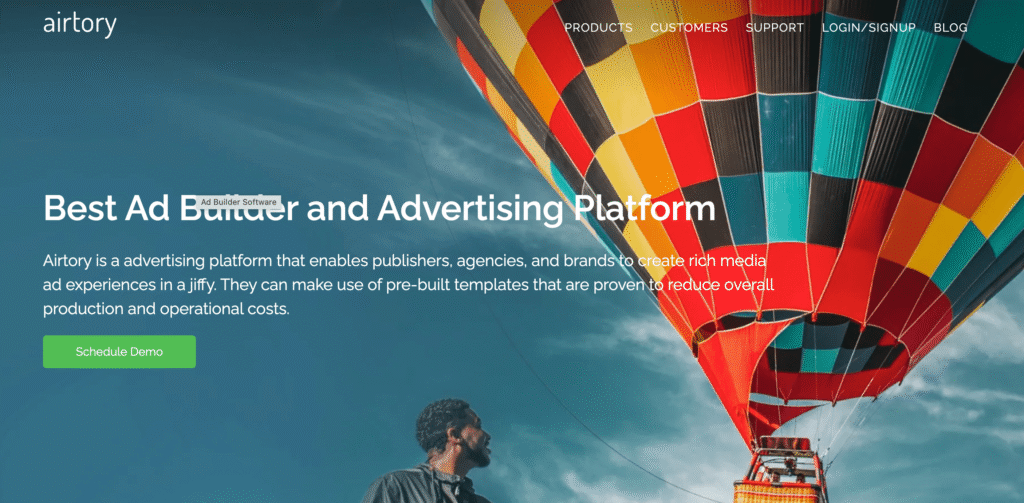
Overview of Airtory
- Airtory is a specialized Creative Management Platform (CMP) designed to streamline the creation, deployment, and management of interactive digital advertisements.
- By integrating content creation, real-time collaboration, and project oversight, Airtory empowers marketing teams and creative professionals to deliver high-quality interactive campaigns efficiently.
- Its focus on interactive ad formats and collaborative workflows positions Airtory as one of the top Creative Management Software solutions in 2025, particularly for organizations seeking engagement-driven digital campaigns.
Quantitative Performance Metrics
- Niche Recognition: Airtory is recognized as the “Most Niche” creative management platform, highlighting its specialization in interactive ads.
- User Feedback: Receives notable recognition on platforms like Slashdot, with 11 user ratings reflecting early adoption and market interest.
- Pricing Structure: Offers a cost-effective plan at $10 per user per month, making it accessible for small teams and individual creators.
- Trial Accessibility: Provides a 14-day free trial, allowing potential users to evaluate features and workflow integration before commitment.
Key Features and Functionalities
- Interactive Ad Creation: Simplifies the production of engaging digital ad formats that enhance user interaction and campaign effectiveness.
- No-Code Platform: Eliminates technical barriers, allowing creative teams to build ads without coding expertise.
- Content Creation Tools: Centralizes creative processes, enabling teams to generate, edit, and refine content efficiently.
- Real-Time Collaboration: Facilitates seamless teamwork with live updates, annotations, and shared feedback.
- Project Management Capabilities: Supports end-to-end oversight of creative campaigns, from initial concept to final deployment.
User Experience Insights
- Streamlined Workflow: Users report Airtory unifies all aspects of content creation into a single, intuitive platform.
- Enhanced Engagement: Interactive ad formats increase audience involvement and campaign performance compared to static ads.
- Collaborative Advantage: Real-time collaboration reduces delays, ensures alignment among team members, and accelerates project timelines.
- Accessibility and Affordability: The low-cost pricing model enables smaller teams and publishers to leverage sophisticated ad creation tools without significant investment.
Strategic Market Position
- Niche Specialization: Airtory distinguishes itself by concentrating on interactive digital advertising, a segment that drives higher engagement and brand recall.
- Versatility Across Teams: Suitable for publishers, advertisers, brands, and creative teams seeking a cohesive solution for managing interactive campaigns.
- Operational Efficiency: Combines creative development, collaboration, and project management in a single platform, reducing reliance on multiple tools.
- Market Recognition: Early adoption and positive feedback indicate growing credibility within the interactive ad management space.
Comparative Overview (Sample Matrix)
| Feature | Airtory Value | Competitor Average | Advantage/Impact |
|---|---|---|---|
| Interactive Ad Support | Full interactive ad creation | Limited interactivity | Higher user engagement |
| No-Code Platform | Fully accessible without technical skills | Requires coding | Expands usability to all teams |
| Collaboration | Real-time feedback and shared editing | Basic collaboration | Streamlines workflows and reduces delays |
| Project Management | End-to-end campaign oversight | Partial management | Ensures alignment and timely delivery |
| Pricing | $10/user/month with 14-day free trial | $20-$50/user/month | Affordable for SMBs and individual users |
Conclusion
Airtory establishes itself as a top Creative Management Software in 2025 by offering a focused solution for interactive digital advertising. Its combination of no-code ad creation, real-time collaboration, and integrated project management makes it ideal for teams seeking to enhance engagement and operational efficiency. Affordable pricing and niche specialization further reinforce its appeal to small and mid-sized organizations, publishers, and creative teams aiming to produce impactful, interactive campaigns with minimal complexity.
7. Wrike
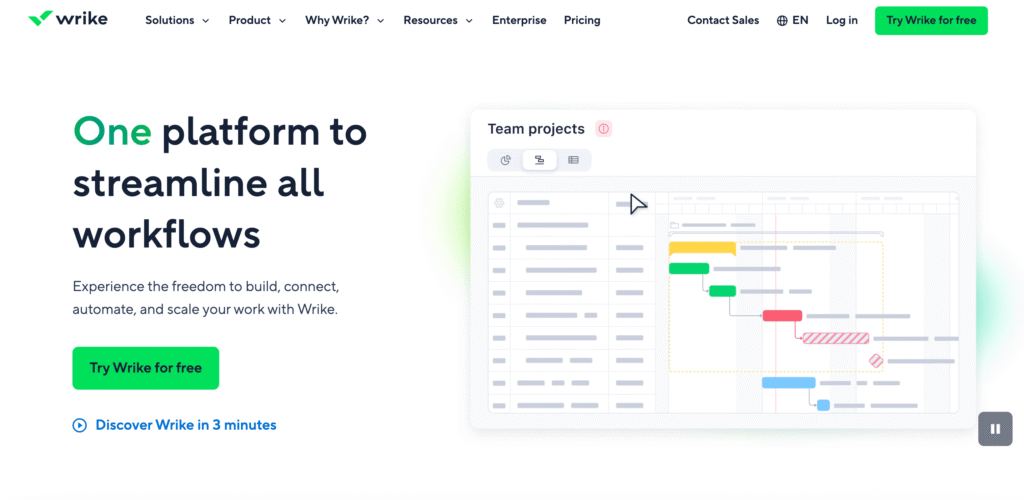
Overview of Wrike
- Wrike is a versatile work and project management platform designed to enhance collaboration, streamline complex workflows, and support creative teams in executing high-impact projects.
- Its adaptability and breadth of features make it a preferred solution for organizations of varying sizes, particularly those managing intricate projects with multiple stakeholders.
- Recognized as one of the top Creative Management Software solutions in 2025, Wrike integrates project oversight, creative collaboration, and productivity optimization within a single platform.
Quantitative Performance Metrics
- G2 Rating: 4.2 out of 5 stars based on 1,611 reviews.
- Capterra Rating: 4.3 out of 5 stars.
- TrustRadius Score: 8.3 out of 10, reflecting high user satisfaction.
- Pricing Structure: Starts at $9.80 per user per month, offering flexibility for small teams and enterprise organizations alike.
- ROI Metrics: A Forrester study reported a remarkable 396% return on investment over three years for organizations implementing Wrike.
- User Base: Approximately 7,760 companies worldwide leverage Wrike for project management and creative collaboration.
Key Features and Functionalities
- Project and Task Management: Enables comprehensive oversight of tasks, milestones, and project deliverables with customizable workflows.
- Visualization Tools: Interactive Gantt charts and Kanban boards provide clear project tracking, timeline management, and workload distribution.
- Time Tracking and Resource Management: Monitors team productivity and allocation to optimize project efficiency.
- Collaboration Tools: Includes file sharing, comments, proofing, and approval workflows specifically tailored for creative teams.
- AI-Powered Productivity Enhancements: Integrates artificial intelligence to streamline routine processes, suggest optimizations, and reduce manual effort.
User Experience Insights
- Scalability: Users highlight Wrike’s effectiveness in managing large-scale projects without overwhelming team members.
- Customizability: Highly adaptable interface and workflows allow teams to tailor the platform to specific creative or operational needs.
- Creative Team Enablement: Specialized features for proofing, approval, and feedback workflows support marketing, design, and content teams.
- Measurable Impact: High ROI and positive feedback emphasize its efficiency in improving productivity, team coordination, and project delivery outcomes.
Strategic Market Position
- Versatile Solution: Serves a broad spectrum of industries and team sizes, positioning Wrike as both a project management and creative management solution.
- Large-Project Optimization: Excels with complex projects, multi-team collaboration, and cross-functional dependencies.
- ROI-Oriented Adoption: Proven financial impact strengthens Wrike’s credibility as a strategic investment for organizations.
- Integration Capability: Offers robust integration with third-party tools, enhancing workflow continuity and data consolidation.
Comparative Overview (Sample Matrix)
| Feature | Wrike Value | Competitor Average | Advantage/Impact |
|---|---|---|---|
| Project Management | Comprehensive, customizable workflows | Basic task tracking | Supports complex projects and teams |
| Visualization Tools | Gantt charts, Kanban boards | Limited visualization | Enhanced timeline and workload management |
| Collaboration | File sharing, proofing, approval workflows | Minimal collaboration | Streamlines creative team coordination |
| AI Enhancements | Productivity automation and optimization | Limited AI support | Reduces manual effort, increases efficiency |
| Pricing | $9.80/user/month | $15-$20/user/month | Cost-effective for SMBs and enterprises |
Conclusion
Wrike solidifies its position as a top Creative Management Software in 2025 by combining comprehensive project oversight, robust collaboration features, and AI-powered productivity tools. Its scalability, customizable workflows, and specialized features for creative teams enable organizations to manage complex projects efficiently while optimizing resource allocation. Positive user feedback, high ROI metrics, and a strong global user base underscore Wrike’s effectiveness as a versatile and reliable platform for creative and operational project management.
8. monday.com

Overview of monday.com
- monday.com is a highly visual and versatile work management platform, designed to enable teams to plan, execute, and monitor projects with efficiency and clarity.
- Its adaptability and extensive customization options make it particularly suitable for creative teams seeking a centralized platform for project management, workflow automation, and collaboration.
- Recognized as one of the top Creative Management Software solutions in 2025, monday.com combines visual clarity, automation, and integration capabilities to streamline creative workflows and enhance team productivity.
Quantitative Performance Metrics
- G2 Rating: 4.7 out of 5 stars from over 10,600 reviews.
- Capterra Rating: 4.6 out of 5 stars.
- TrustRadius Score: 8.5 out of 10, reflecting high user satisfaction and reliability.
- Pricing Structure: Starts at $9 per seat per month, offering scalability for teams of all sizes.
- Market Share: Holds a significant 5.7% share in the Project Management category.
- Revenue and Adoption: Generated $972 million in fiscal year 2024, with approximately 10,000 companies using the platform globally.
Key Features and Functionalities
- Customizable Workflows: Enables teams to design and implement workflows tailored to specific project requirements, with drag-and-drop functionality for ease of use.
- Visual Dashboards: Provides real-time tracking of project progress, resource allocation, and deadlines through interactive visual dashboards.
- Project and Task Management: Comprehensive features for task assignment, milestone tracking, dependency management, and performance monitoring.
- Automation Capabilities: Streamlines repetitive tasks, notifications, and updates to save time and minimize manual effort.
- Integration Ecosystem: Seamless integration with a wide range of third-party tools ensures continuity across marketing, design, and operational workflows.
- Collaboration Features: Facilitates team communication, file sharing, and feedback within a unified workspace to maintain alignment and efficiency.
User Experience Insights
- Workflow Optimization: Users highlight monday.com’s effectiveness in automating processes and enhancing operational efficiency.
- Visual Appeal: The highly visual interface improves clarity, reduces complexity, and accelerates onboarding for team members.
- Versatility Across Teams: Suitable for creative, operational, and cross-functional teams, allowing both project and resource management in a single platform.
- User Satisfaction: High ratings across multiple platforms underscore its usability, scalability, and impact on productivity.
Strategic Market Position
- Creative Workflow Enablement: monday.com excels in supporting creative teams with visual project management, customizable workflows, and centralized collaboration.
- Scalability: Accommodates both small teams and large enterprises, making it versatile for organizations of all sizes.
- Automation and Efficiency: Reduces manual workload through automated processes, enhancing team focus on high-value creative tasks.
- Market Credibility: Strong adoption, substantial revenue, and notable market share reflect confidence among global organizations in its capabilities.
Comparative Overview (Sample Matrix)
| Feature | monday.com Value | Competitor Average | Advantage/Impact |
|---|---|---|---|
| Customizable Workflows | Drag-and-drop, fully tailored workflows | Limited customization | Adaptable to diverse team needs |
| Visual Dashboards | Real-time, interactive project tracking | Basic dashboards | Enhanced clarity and project oversight |
| Automation | Streamlines repetitive tasks | Minimal automation | Saves time, reduces errors |
| Integration | Wide third-party tool compatibility | Restricted integrations | Seamless workflow continuity |
| Pricing | $9/seat/month | $15-$20/seat/month | Cost-effective for teams of all sizes |
Conclusion
monday.com stands out as a top Creative Management Software in 2025 due to its highly visual approach, robust customization, and scalable solutions for teams of all sizes. Its combination of workflow automation, real-time dashboards, and extensive integrations allows creative teams to manage projects efficiently while maintaining flexibility and operational clarity. Strong user ratings, significant market share, and global adoption reinforce its position as a reliable and versatile platform for modern creative project management.
9. ClickUp

Overview of ClickUp
- ClickUp is a comprehensive all-in-one work management platform designed to unify multiple workflows and enhance productivity for creative teams.
- Its extensive feature set and high adaptability make it suitable for teams ranging from small startups to large enterprises, aiming to consolidate project management, collaboration, and creative processes within a single solution.
- Recognized as one of the top Creative Management Software solutions in 2025, ClickUp combines flexibility, automation, and AI-powered tools to streamline project execution and improve team efficiency.
Quantitative Performance Metrics
- G2 Rating: 4.7 out of 5 stars based on over 9,000 reviews.
- Capterra Rating: 4.7 out of 5 stars, reflecting consistent user satisfaction.
- TrustRadius Score: 8.6 out of 10, underscoring its reliability and performance.
- Pricing Structure: Starting at $7 per user per month, offering an accessible entry point for individuals and small teams.
- Market Adoption: Over 10 million users and 2 million teams worldwide rely on ClickUp for workflow management.
- Market Share and Revenue: Holds 0.3% in the Project Management category, with $278.5 million in revenue in fiscal year 2024, demonstrating rapid growth and adoption.
Key Features and Functionalities
- Task and Project Management: Multiple views including list, Kanban, and Gantt charts allow flexible project organization and tracking.
- Document Editing and Whiteboards: Built-in tools facilitate collaborative brainstorming, document creation, and content development.
- Integrated Communication: Chat and comment functionalities support real-time collaboration among team members.
- Automation Capabilities: Streamlines repetitive tasks and optimizes workflows to enhance operational efficiency.
- AI-Powered Tools: Provides intelligent suggestions, predictive analytics, and automation to improve productivity and decision-making.
- Customizability: Highly adaptable platform that can be tailored to unique team workflows and project requirements.
User Experience Insights
- Unified Workspace: Users consistently highlight ClickUp’s ability to centralize tasks, projects, and communication in a single platform.
- Customization and Flexibility: Teams can design workflows, dashboards, and processes to match their specific operational needs.
- Free Plan Advantage: Generous free plan with robust features allows accessibility for small teams and individual users, making it ideal for startups and freelancers.
- AI Integration: Increasing AI capabilities enhance task automation, data analysis, and workflow optimization, appealing to tech-forward teams.
Strategic Market Position
- All-in-One Solution: ClickUp differentiates itself by providing a unified platform for project management, collaboration, and creative workflows.
- Scalability Across Teams: Effective for small teams, mid-market organizations, and large enterprises, supporting both simple and complex workflows.
- Productivity and Efficiency: Automation and AI-driven features reduce manual effort, accelerate project delivery, and optimize resource use.
- Global Adoption: Large user base and rapid revenue growth reflect its credibility, effectiveness, and market traction.
Comparative Overview (Sample Matrix)
| Feature | ClickUp Value | Competitor Average | Advantage/Impact |
|---|---|---|---|
| Task and Project Management | Multiple views (list, Kanban, Gantt) | Limited views | Flexible workflow visualization |
| Collaboration Tools | Integrated chat, comments, document editing | Basic collaboration | Centralizes communication and content creation |
| Automation | Advanced workflow automation | Minimal automation | Reduces manual effort, increases efficiency |
| AI Integration | Predictive analytics and task suggestions | Few AI features | Enhances productivity and decision-making |
| Pricing | $7/user/month with free plan available | $15-$20/user/month | Affordable and accessible for SMBs |
Conclusion
ClickUp establishes itself as a top Creative Management Software in 2025 by combining extreme customizability, robust collaboration, and AI-enhanced workflow management. Its unified workspace, scalable features, and accessible pricing make it a versatile platform suitable for creative teams, operational managers, and enterprises seeking a comprehensive solution for project and work management. High user adoption, strong ratings, and rapid revenue growth underscore ClickUp’s effectiveness, popularity, and long-term market relevance.
10. Asana

Overview of Asana
- Asana is a leading project management platform designed to enhance team collaboration, task prioritization, and overall workflow efficiency.
- Its intuitive interface, combined with comprehensive project management tools, makes it particularly effective for creative teams managing multiple projects and stakeholders.
- Recognized as one of the top Creative Management Software solutions in 2025, Asana integrates task management, workflow automation, and collaborative features to streamline creative operations.
Quantitative Performance Metrics
- G2 Rating: 4.4 out of 5 stars from 11,623 user reviews.
- Capterra Rating: 4.5 out of 5 stars.
- TrustRadius Score: 8.5 out of 10, reflecting strong user satisfaction.
- Pricing Structure: Starting at $10.99 per user per month, making it accessible to both small teams and large organizations.
- Market Share and Adoption: Holds 22.6% of the Project Management category with over 139,000 paying customers in more than 200 countries.
- Market Capitalization: Valued at $4.07 billion USD as of May 2025, reflecting its robust market presence and financial stability.
Key Features and Functionalities
- Task and Project Tracking: Supports multiple view options including list, board, calendar, and timeline for enhanced project visualization.
- Real-Time Collaboration: Enables team members to communicate through comments, file attachments, and collaborative updates.
- Workflow Automation: Automates repetitive tasks and processes to optimize efficiency and reduce manual effort.
- Integration Ecosystem: Offers seamless integration with over 200 third-party applications to maintain workflow continuity across platforms.
- Reporting and Analytics: Provides detailed project insights, progress tracking, and performance metrics to support informed decision-making.
User Experience Insights
- Interface and Usability: Asana is praised for having the “Best User Interface,” allowing teams to navigate and manage projects intuitively.
- Streamlined Task Management: Recognized for simplifying project oversight, task delegation, and deadline tracking for creative teams.
- Customizability: Offers flexible project setups and workflow configurations to align with team-specific requirements.
- Accessibility: Free plan availability makes it accessible for individuals, startups, and small teams, while premium plans support larger enterprises.
Strategic Market Position
- Creative Team Enablement: Asana excels at providing a centralized platform for collaboration, task prioritization, and workflow efficiency for creative teams.
- Enterprise and SMB Adoption: Its scalable architecture supports both small teams and global organizations, ensuring versatility across industries.
- Automation and Productivity: Workflow automation reduces operational overhead, enabling teams to focus on high-value creative tasks.
- Market Leadership: Strong market share, extensive global adoption, and robust financial valuation underscore Asana’s credibility and long-term sustainability.
Comparative Overview (Sample Matrix)
| Feature | Asana Value | Competitor Average | Advantage/Impact |
|---|---|---|---|
| Task and Project Tracking | Multiple views (list, board, calendar, timeline) | Limited views | Enhanced visualization and planning |
| Collaboration Tools | Real-time comments, file attachments | Basic collaboration | Centralizes communication and project updates |
| Workflow Automation | Automates repetitive processes | Minimal automation | Increases efficiency and reduces manual effort |
| Integration | Over 200 third-party app integrations | Limited integrations | Seamless workflow continuity |
| Pricing | $10.99/user/month with free plan available | $15-$20/user/month | Cost-effective for individuals and teams |
Conclusion
Asana solidifies its position as a top Creative Management Software in 2025 by combining intuitive design, workflow automation, and powerful collaboration tools. Its multiple project views, extensive integration capabilities, and strong user satisfaction make it an ideal solution for creative teams, operational managers, and enterprises seeking centralized project and task management. High adoption rates, substantial market share, and robust financial metrics demonstrate Asana’s effectiveness, scalability, and reliability in the creative management software landscape.
11. Nuclino
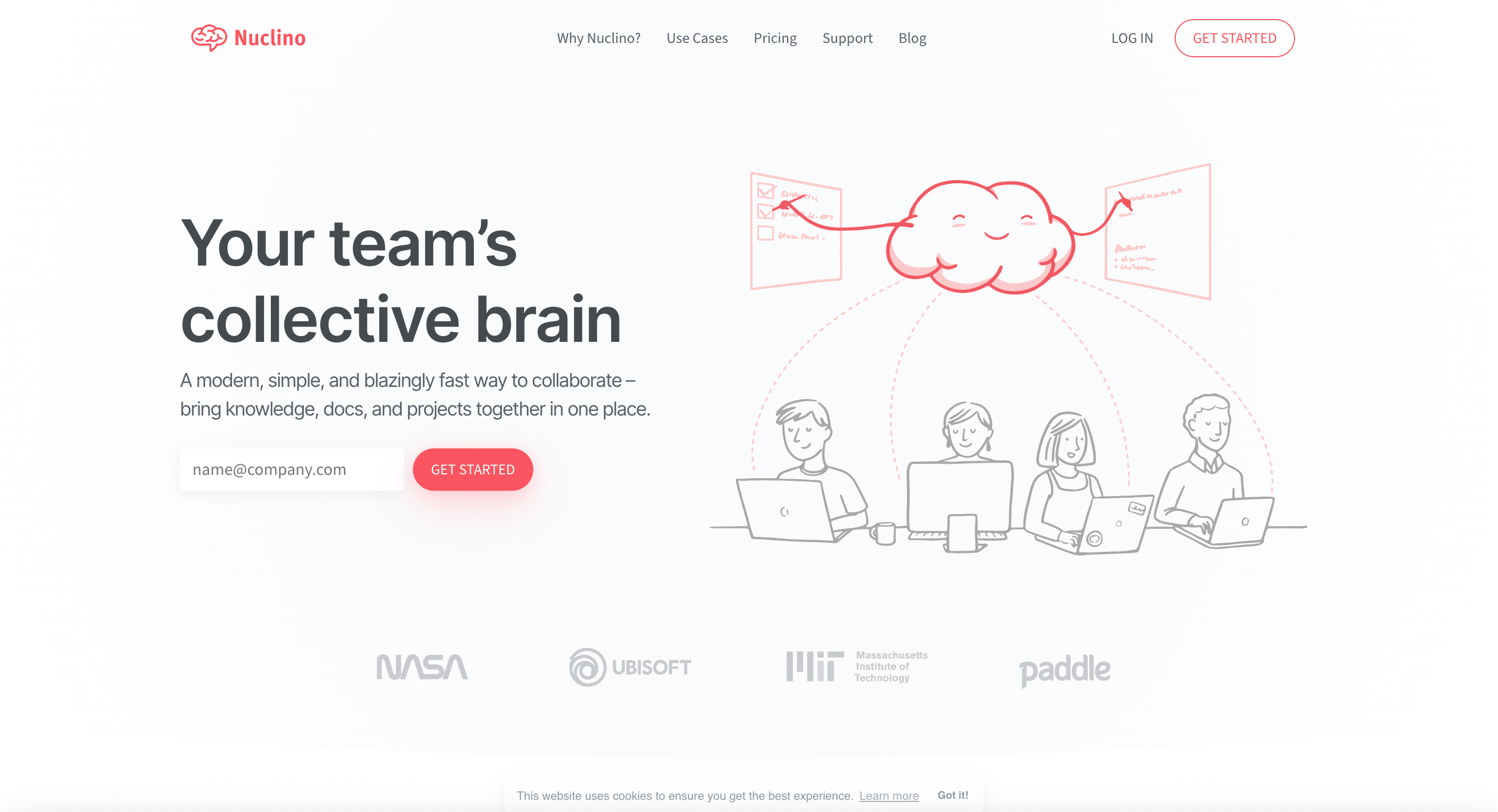
Overview of Nuclino
- Nuclino is a modern, lightweight, and highly intuitive platform designed to support both creative project management and knowledge management needs.
- It focuses on delivering a seamless collaboration environment while providing teams with a structured way to organize work, tasks, and knowledge assets.
- Recognized as one of the top Creative Management Software solutions in 2025, Nuclino appeals to teams seeking simplicity without sacrificing functionality.
Quantitative Performance Metrics
- G2 Rating: 4.7 out of 5 stars based on over 20 reviews, reflecting strong user satisfaction.
- Capterra Rating: 4.7 out of 5 stars, indicating consistent usability and reliability.
- TrustRadius Score: 6.2 out of 10, demonstrating niche market adoption.
- Pricing Structure: Starting at $6 per user per month, offering an affordable solution for small and medium-sized teams.
- User Adoption: Over 12,000 teams globally rely on Nuclino to manage projects and centralize knowledge.
Key Features and Functionalities
- Flexible Project Organization: Supports multiple visual formats including Kanban boards, hierarchical lists, mindmap-style graphs, and tables to suit diverse team preferences.
- Real-Time Collaboration: Enables automatic saving, version history tracking, and simultaneous editing for all team members.
- Knowledge Management: Functions as a centralized knowledge base, allowing teams to document best practices, project details, and institutional knowledge.
- Integration Capabilities: Compatible with various workflow and productivity tools, enabling seamless incorporation into existing team processes.
User Experience Insights
- Ease of Use: Users consistently praise Nuclino for its simplicity and intuitiveness, with a clean and modern interface that encourages team engagement.
- Accessibility: Minimal learning curve allows new team members to quickly adopt the platform.
- Engagement and Collaboration: Visual project organization combined with real-time collaboration enhances team productivity and communication.
- Positive Feedback: Users highlight the platform as “perfect” for small teams and commend its design for being inviting and easy to navigate.
Strategic Market Position
- Dual Functionality: Combines project management with knowledge management, providing unique value by centralizing both work and information.
- Affordability and Accessibility: Low starting price makes it highly accessible for small and medium-sized creative teams, startups, and remote teams.
- Streamlined Workflows: By simplifying complex project and knowledge management tasks, Nuclino reduces overhead and accelerates productivity.
- Niche Advantage: Its lightweight design and user-focused interface distinguish it from heavier, more complex creative management platforms.
Comparative Overview (Sample Matrix)
| Feature | Nuclino Value | Competitor Average | Advantage/Impact |
|---|---|---|---|
| Visual Project Organization | Kanban, lists, mindmaps, tables | Limited views | Flexible and adaptive workflow visualization |
| Real-Time Collaboration | Automatic saving, version history, simultaneous editing | Basic collaboration | Enhances productivity and reduces errors |
| Knowledge Management | Centralized knowledge base | Rare in project tools | Combines project and knowledge management in one platform |
| Pricing | $6/user/month | $10-$20/user/month | Affordable for SMBs and small creative teams |
| User Engagement | Highly intuitive and easy-to-adopt interface | Moderate usability | Encourages team adoption and seamless onboarding |
Conclusion
Nuclino establishes itself as one of the top Creative Management Software solutions in 2025 through its emphasis on simplicity, affordability, and dual project and knowledge management capabilities. Its lightweight design, multiple visual organizational formats, and strong real-time collaboration tools make it particularly suited for small to medium-sized creative teams. Nuclino’s positive user feedback, accessibility, and capacity to streamline workflows position it as a compelling choice for teams seeking an intuitive, efficient, and cost-effective platform for managing projects and knowledge simultaneously.
Defining Creative Management Software
- Creative Management Software (CMS) is a specialized category of cloud-based platforms designed to consolidate essential tools for marketing and advertising professionals.
- Unlike Digital Asset Management (DAM) systems, which primarily focus on storing, organizing, and distributing digital assets, CMS extends its functionality to the creation, review, approval, and deployment of marketing and advertising creatives.
- Unlike general Project Management Software, which provides tools for managing tasks across multiple domains, CMS specifically addresses the complexities inherent in creative projects, offering tailored solutions for design workflows, campaign execution, and asset personalization.
- While Workflow Management Software automates a wide array of business processes, CMS incorporates dedicated features for creative project management, including centralized asset repositories, version control, and collaborative tools.
- Core CMS functionalities typically include:
- Creative asset management for organizing and maintaining brand-consistent visuals.
- Workflow automation that optimizes creative processes, such as review cycles and content approval.
- Collaboration tools designed for creative teams, including annotation, commenting, and real-time editing.
- Campaign management features focused on creative execution, tracking, and delivery.
- Dynamic Creative Optimization (DCO), enabling personalization of ad experiences based on audience data, driving higher engagement and conversion rates.
The Role of CMS in Modern Marketing and Creative Workflows
- Marketing teams today face the challenge of managing increasing volumes of creative content distributed across multiple digital channels. CMS platforms address this by offering a centralized environment for the entire creative lifecycle.
- Key contributions of CMS to modern workflows include:
- Seamless collaboration among designers, marketers, copywriters, and stakeholders through integrated workspaces.
- Streamlined feedback mechanisms via annotations, comments, and shared project boards, ensuring alignment across teams.
- Maintaining brand consistency through centralized libraries, standardized templates, and approval workflows.
- Ensuring compliance with brand guidelines and marketing standards through version control and access management.
- By integrating these capabilities, CMS platforms not only improve operational efficiency but also ensure that creative outputs are accurate, on-brand, and aligned with marketing strategies.
Key Benefits Offered by CMS
- Enhanced Efficiency and Productivity
- Automation of repetitive tasks such as ad resizing, asset routing, and workflow approvals.
- Streamlined creative processes that reduce bottlenecks and accelerate project timelines.
- Improved Collaboration and Communication
- Unified platforms where teams can share feedback, track project status, and access assets seamlessly.
- Real-time updates and annotation features that enhance cross-functional collaboration.
- Optimized Review and Approval Processes
- Direct asset annotations, side-by-side version comparisons, and automated stakeholder routing simplify approvals.
- Reduces errors, rework, and miscommunication, leading to higher-quality outputs.
- Brand Control and Governance
- Centralized storage and robust search functionalities ensure only approved assets are used.
- Permission management maintains brand consistency across campaigns and channels.
- Data-Driven Insights and Performance Analytics
- Integrated analytics allow marketers to track asset performance and audience engagement.
- Provides actionable insights to optimize future campaigns and improve ROI.
- Faster Time-to-Market
- By accelerating production and approval cycles, CMS reduces campaign launch times.
- Enables organizations to respond quickly to emerging trends and market opportunities.
- Cost Efficiency and Resource Optimization
- Automation and streamlined workflows reduce operational costs.
- Efficient resource allocation enhances the return on investment for marketing campaigns.
Visual Overview (Sample Matrix)
| CMS Feature | Benefit | Business Impact |
|---|---|---|
| Creative Asset Management | Centralized libraries and version control | Maintains brand consistency and reduces errors |
| Workflow Automation | Task routing, resizing, approvals | Accelerates production and reduces manual work |
| Collaboration Tools | Real-time editing, annotation, comments | Enhances team productivity and alignment |
| Dynamic Creative Optimization | Personalized ad content | Increases engagement and conversion rates |
| Performance Analytics | Asset insights and reporting | Informs optimization strategies and ROI |
Conclusion
- Creative Management Software is an indispensable solution for modern marketing and advertising teams, bridging the gap between project management, asset management, and campaign execution.
- By centralizing creative processes, automating repetitive tasks, and providing analytics-driven insights, CMS platforms enable organizations to enhance productivity, maintain brand integrity, reduce time-to-market, and maximize the efficiency of creative campaigns.
- The adoption of CMS represents a strategic investment for businesses seeking to streamline creative workflows, empower collaborative teams, and achieve measurable results in an increasingly competitive digital landscape.
Criteria for Evaluating Creative Management Software
Core Features and Functionalities
When selecting a Creative Management Software (CMS) platform, organizations must prioritize a comprehensive suite of capabilities designed to meet the full spectrum of creative production needs.
- Creative Asset Management
- Secure cloud-based storage with role-based permissions.
- Intelligent metadata tagging for precise categorization and rapid retrieval.
- Advanced search capabilities enabling instant location of specific creative assets.
- Workflow Automation
- End-to-end lifecycle coverage from brief creation to campaign delivery.
- Customizable workflow templates adaptable to various creative team structures.
- Automated routing for approvals and content publishing.
- Collaboration Tools
- Direct in-platform annotations and threaded comments on creative assets.
- Robust version control with detailed change history logs.
- Real-time communication channels for synchronized team engagement.
- Campaign Management
- Integrated planning tools for creative asset deployment across multiple channels.
- Scheduling and tracking features to monitor asset performance and delivery.
- Dynamic Creative Optimization (DCO) and Personalization
- AI-driven content customization based on user preferences and behavioral data.
- Adaptive creatives to improve engagement and conversion rates.
- Performance Analytics
- In-depth reporting on engagement, click-through rates, and conversions.
- Insights to refine creative strategy and allocate resources effectively.
- Design Tool Integration
- Seamless connectivity with Adobe Creative Cloud, Figma, and other design platforms.
- Real-time synchronization between design tools and CMS asset libraries.
Feature Impact Table
| Feature | Operational Benefit | Strategic Impact |
|---|---|---|
| Creative Asset Management | Fast retrieval and organized storage | Maintains brand integrity across channels |
| Workflow Automation | Reduced manual workload | Accelerates campaign delivery timelines |
| Collaboration Tools | Centralized feedback and revisions | Enhances cross-functional alignment |
| Dynamic Creative Optimization (DCO) | Personalized ad experiences | Higher engagement and improved ROI |
| Analytics and Reporting | Performance-driven decision-making | Continuous creative optimization |
Pricing Models
The financial structure of CMS solutions plays a decisive role in vendor selection.
- Subscription-Based Pricing
- Per-user/month rates, common in platforms like Asana, Wrike, and monday.com.
- Tiered feature access based on business requirements and scale.
- Flat-Rate Pricing
- Single monthly fee covering a fixed number of users, ideal for small teams.
- Free Plans and Trials
- Risk-free evaluations before financial commitment.
- Widely adopted by SaaS providers to facilitate adoption in budget-conscious environments.
- Value Assessment
- Organizations should weigh features, integrations, and support against pricing to determine cost-effectiveness.
User Reviews and Ratings
Leveraging peer feedback offers valuable insights into real-world CMS performance.
- Ease of Use
- Influences adoption speed and daily productivity.
- Customer Support Quality
- Response times, onboarding assistance, and problem resolution speed are critical.
- Overall Satisfaction Scores
- Ratings on G2, Capterra, and TrustRadius reflect collective sentiment.
- Bias Awareness
- Verification processes on review platforms help ensure authenticity.
Market Presence and Vendor Landscape
Understanding a vendor’s market standing provides insight into product maturity and industry adoption.
- Market Share Insights
- Bynder: 0.5% in Digital Asset Management.
- monday.com: 5.7% in Project Management.
- Asana: 22.6% in Project Management.
- ClickUp: 0.3% in Project Management.
- Target Market Alignment
- AdCreative.ai: Primarily small businesses.
- Bynder: Mid-market to enterprise.
- Wrike: Large agencies.
- monday.com: Teams of all sizes.
Market Position Matrix
| Platform | Market Segment | Share (%) | Typical Users |
|---|---|---|---|
| Bynder | Digital Asset Management | 0.5 | Mid-market, enterprise |
| monday.com | Project Management | 5.7 | All business sizes |
| Asana | Project Management | 22.6 | Collaboration-focused teams |
| ClickUp | Project Management | 0.3 | Customization-focused organizations |
Innovation and Future-Readiness
In a rapidly evolving technology ecosystem, CMS adaptability is a competitive advantage.
- AI Integration
- Predictive ad performance scoring.
- Automated workflow optimization.
- Intelligent content generation.
- Product Roadmaps
- Commitment to ongoing enhancements and alignment with emerging market trends.
Integration Capabilities
Effective CMS platforms operate as part of a larger marketing technology ecosystem.
- Key Integrations
- CRM systems such as Salesforce.
- Digital Asset Management platforms.
- Advertising platforms like Google Ads and Facebook Ads.
- API Availability
- Enables bespoke integrations and custom workflows.
Ease of Use and User Interface
An intuitive CMS interface accelerates adoption and minimizes training overhead.
- User-Friendly Platforms
- Trello, Asana, ClickUp, monday.com, and Nuclino recognized for accessibility.
- Learning Curve Considerations
- Simple platforms facilitate quick adoption; more complex systems may require structured onboarding.
Customer Support and Training
Ongoing support ensures long-term CMS success.
- Support Channels
- Live chat, email, and phone assistance.
- Training Resources
- Knowledge bases, tutorials, and structured onboarding programs.
- Onboarding Excellence
- Ensures smooth adoption and early productivity gains.
Scalability and Flexibility
A robust CMS should evolve alongside the organization’s growth.
- Scalable Solutions
- Smartsheet, Microsoft Project, and Asana accommodate expanding teams.
- Customization Options
- Tailored workflows and templates, as seen in ClickUp and monday.com.
Market-Leading Solutions Overview
The competitive landscape of Creative Management Software (CMS) in 2025 showcases a range of platforms tailored for diverse creative, marketing, and operational needs. These solutions vary widely in pricing, functionality, scalability, and integration capabilities, making direct comparison a critical step in informed decision-making.
Comprehensive Comparison Table
| Software | Pricing (Starting/User/Month) | Distinctive Features & Capabilities | Ease of Use (G2 Rating) | Notable Integrations | Customer Support Insights | Ideal Target Audience |
|---|---|---|---|---|---|---|
| AdCreative.ai | $29 | AI-driven ad creation, dynamic creative optimization (DCO), performance scoring | 4.3/5 | Google Ads, Facebook, Instagram, Zapier | Not prominently stated | Startups, SMEs seeking fast, data-driven ad campaigns |
| Bynder | ~ $450 | DAM, brand governance, AI-powered search, creative workflow automation | 4.5/5 | Adobe Creative Cloud, Slack, Salesforce, Google Drive | Highly praised | Mid-market and enterprise organizations |
| Ziflow | $199 (Teams) | Online proofing, automated approval workflows, AI copy suggestions | 4.5/5 | Adobe Creative Cloud, Slack, Jira, Google Drive, Dropbox | Not prominently stated | Agencies, creative production teams |
| Bannerflow | Custom | Drag-and-drop creative editor, automated asset resizing, ad campaign management | 4.6/5 | Google Ads, Meta, LinkedIn, YouTube | Commended for responsiveness | Mid-market and large-scale advertisers |
| Celtra | Custom | Creative automation, ad personalization, analytics-driven optimization | 4.4/5 | Google & Adobe product ecosystems | Not prominently stated | Small businesses and mid-sized marketing teams |
| Airtory | $10 | Interactive ad creation, collaboration tools, campaign management | Not Available | Google Drive, Slack, Trello, Jira, Adobe Creative Cloud | Not prominently stated | Publishers, advertisers, brand teams |
| Wrike | $9.80 | Custom workflows, Gantt charts, Kanban boards, time tracking | 4.2/5 | Google Drive, Dropbox, Slack, Salesforce, Adobe | 24/7 global support | All company sizes, particularly large organizations |
| monday.com | $9 | Visual dashboards, process automation, scalable integrations | 4.7/5 | Slack, Dropbox, Adobe Creative Cloud, Google Drive | 24/7 support | Flexible for teams of any size |
| ClickUp | $7 | All-in-one task management, multiple view formats, AI productivity tools | 4.7/5 | Slack, Google Drive, Trello, Asana, Jira | 24/7 support | Versatile for diverse operational and creative teams |
| Asana | $10.99 | Task tracking, automated workflows, cross-functional collaboration | 4.4/5 | Slack, Google Drive, Microsoft Teams, Adobe Creative Cloud | Not prominently stated | Teams prioritizing structured collaboration |
| Nuclino | $6 | Knowledge and project management, mind-map and Kanban visuals, real-time edits | 4.7/5 (limited reviews) | Slack, Google Drive | Praised for responsiveness | Startups and small creative teams seeking simplicity |
Demonstrated Return on Investment (ROI) through Case Studies
- Wrike
- 396% ROI over three years, according to Forrester 2023.
- Gains achieved through agile resource allocation, improved operational transparency, and enhanced alignment across departments.
- ClickUp
- 1645% ROI for a U.S. construction firm by optimizing proposal generation and deal sourcing.
- Efficiency improvements between 15–25% for teams using its multi-functional task management tools.
- Average investment recovery in just over one month.
- monday.com
- Canva achieved a 300% uplift in ad production capacity, 40% faster creative cycles, and supported a 522% expansion in operational scope.
- Zippo Manufacturing Company reported an 8x ROI through accelerated product category launches and market diversification.
- Hive
- Enabled Arden Grange to double its direct-to-consumer business in five months while maintaining a 99% on-time fulfillment rate.
Emerging Trends and Future Outlook for 2025 and Beyond
- AI-Driven Creative Transformation
- AI is increasingly embedded in CMS platforms for automated ad copy generation, dynamic creative personalization, predictive campaign analytics, and intelligent workflow automation.
- Integration-Centric Ecosystems
- Demand for seamless CRM, DAM, and ad network integrations continues to grow, enabling unified data-driven decision-making across marketing and creative teams.
- Collaborative Creative Hubs
- Platforms are evolving into centralized operational hubs, allowing real-time collaboration between creative, marketing, and analytics departments.
- Performance-Centric Analytics
- Enhanced reporting capabilities now allow granular measurement of engagement, conversion, and ROI, enabling more agile creative strategy adjustments.
- Emerging Technologies
- Early-stage exploration of Web3 and blockchain for digital asset authentication and secure distribution within creative workflows is underway, signaling potential industry disruption.
Expert Recommendations for Selecting Creative Management Software in 2025
The Creative Management Software (CMS) market in 2025 presents an extensive spectrum of platforms, each uniquely positioned to address different operational, creative, and strategic requirements. Selecting the right solution requires a nuanced understanding of both the software’s capabilities and the organization’s own objectives.
Strategic Platform Highlights
- AdCreative.ai
- Excels in AI-powered advertisement creation and dynamic creative optimization.
- Ideal for performance marketing teams aiming to boost engagement through data-driven design.
- Bynder
- Comprehensive Digital Asset Management (DAM) platform integrated with automated workflows.
- Tailored for mid-sized to large enterprises with vast creative libraries and complex brand governance needs.
- Ziflow
- Specializes in online proofing, compliance review, and multi-stage approval workflows.
- Particularly advantageous for industries with stringent regulatory requirements.
- Bannerflow
- Focused on simplifying digital display advertising, campaign scaling, and cross-platform publishing.
- Valuable for organizations prioritizing rapid creative deployment.
- Celtra
- Delivers creative automation, data-backed optimization, and asset personalization.
- Designed for media-rich advertising campaigns across diverse digital channels.
- Airtory
- Distinguished for interactive and immersive ad creation capabilities.
- Suitable for publishers, advertisers, and creative teams seeking high-engagement formats.
- Wrike
- A robust project management solution enhanced with creative workflow features.
- Adaptable to a wide range of team sizes, offering advanced tracking and reporting functions.
- monday.com
- Highly visual and customizable work management platform with scalable automation.
- Effective for multidisciplinary creative operations and collaborative environments.
- ClickUp
- Comprehensive all-in-one productivity suite with embedded AI features.
- Flexible for teams seeking to unify project management, documentation, and creative processes.
- Asana
- Renowned for collaboration-driven task and workflow management.
- Best suited for teams emphasizing structured coordination and cross-functional visibility.
- Nuclino
- Lightweight yet powerful tool for project and knowledge management.
- Optimized for smaller creative teams and startups requiring simplicity and speed.
Decision-Making Matrix for Creative Management Software Selection
| Criteria | Best Options | Why They Excel |
|---|---|---|
| AI-Driven Ad Creation | AdCreative.ai, ClickUp | Harnesses AI for ad generation, targeting, and creative optimization |
| Comprehensive DAM | Bynder, Wrike | Robust digital asset libraries with advanced search and governance tools |
| Regulatory Compliance | Ziflow | Streamlined proofing and compliance checks for sensitive industries |
| Advertising Campaigns | Bannerflow, Celtra, Airtory | Designed for high-volume, multi-channel advertising execution |
| Scalable Collaboration | monday.com, Asana, ClickUp | Highly adaptable workflows with integration capabilities for growing teams |
| Lightweight Simplicity | Nuclino, Asana (Free Plan) | Minimal setup complexity with straightforward collaboration features |
Key Considerations Before Choosing a CMS
- Business Requirements
- Identify core operational needs: ad creation, asset management, campaign reporting, or team collaboration.
- Match platform strengths with priority use cases.
- Budget Alignment
- Evaluate pricing models and scalability costs.
- Factor in potential ROI gains from automation, collaboration, and campaign efficiency.
- Integration Compatibility
- Ensure seamless interoperability with CRM, DAM, marketing automation platforms, and advertising networks.
- User Experience and Adoption
- Prioritize intuitive interfaces to reduce onboarding time and improve adoption rates.
- Conduct pilot programs to assess user engagement before full rollout.
- Stakeholder Involvement
- Engage creative, marketing, and IT teams early in the selection process to align expectations.
- Collect feedback from all relevant departments during trials.
Implementation Best Practices
- Trial Before Commitment
- Utilize free trials or freemium versions to evaluate fit and performance.
- Test core workflows with real campaigns to assess practical value.
- Workflow Mapping
- Document current creative processes to identify inefficiencies and integration opportunities.
- Change Management
- Provide structured onboarding sessions, user training, and resource documentation.
- Performance Monitoring
- Track KPIs such as campaign speed-to-market, asset reuse rates, and ROI post-implementation.
Impact of the Right CMS
When carefully selected and strategically implemented, a CMS can:
- Dramatically reduce production timelines.
- Ensure brand consistency across global markets.
- Improve collaboration between creative, marketing, and operations teams.
- Enhance campaign performance through real-time data-driven insights.
- Generate measurable ROI through resource optimization and faster time-to-market.
Conclusion
The year 2025 marks a pivotal moment in the evolution of Creative Management Software (CMS), as businesses across industries increasingly recognise that creative operations are no longer secondary to core marketing functions—they are the driving force behind brand differentiation, audience engagement, and revenue growth. The tools highlighted in this in-depth analysis, from AI-powered solutions like AdCreative.ai to enterprise-grade platforms such as Bynder and workflow-centric systems like Wrike, collectively reflect the transformative potential of technology in streamlining, scaling, and optimising creative production.
What becomes abundantly clear from this comparative exploration is that there is no universal “best” CMS. Instead, the right choice is determined by an organisation’s unique combination of creative goals, operational challenges, and growth ambitions. Smaller creative teams or startups may prioritise lightweight, cost-effective solutions like Nuclino or Asana’s entry-level plans, which provide agility and ease of adoption without the burden of excessive complexity. Meanwhile, mid-sized and enterprise-level organisations—particularly those managing vast asset libraries or intricate campaign workflows—stand to benefit most from robust platforms such as Bynder, Wrike, or monday.com, where scalability, integration breadth, and governance tools are critical for operational success.
Equally important is the realisation that today’s CMS platforms are no longer limited to asset storage or project tracking. They have evolved into fully integrated creative ecosystems that unite asset management, campaign planning, collaboration, automation, performance analytics, and even AI-driven content generation under a single operational umbrella. This shift not only accelerates production timelines but also enables data-informed creative decisions, ensuring that each campaign is not just executed efficiently but also strategically aligned with business objectives.
The practical benefits are measurable and compelling. As case studies demonstrate, implementing the right CMS can lead to significant ROI, whether through accelerated time-to-market, improved team productivity, increased creative output, or enhanced campaign performance. Brands like Canva, Zippo, and others have demonstrated how effectively chosen and well-implemented creative management solutions can multiply output capacity, improve brand consistency, and support exponential growth in market reach. These examples prove that CMS adoption is not simply a technological upgrade—it is a business transformation strategy.
Looking ahead, several trends are set to define the CMS landscape. Artificial Intelligence will continue to expand its role, enabling even deeper automation, smarter asset optimisation, and predictive creative performance analytics. Integration capabilities will become even more critical, with businesses demanding seamless interoperability between CMS platforms and their marketing technology stacks, from CRM systems to programmatic advertising tools. Moreover, as emerging technologies such as Web3 and blockchain mature, we may see entirely new paradigms in digital asset security, ownership verification, and decentralised creative collaboration.
For decision-makers, the path forward involves more than just comparing feature lists and subscription fees. It requires a holistic evaluation of business priorities, creative workflows, stakeholder expectations, and long-term scalability needs. By conducting structured trials, engaging cross-functional teams in the selection process, and clearly defining success metrics, organisations can ensure that their chosen CMS is not merely a tool, but a catalyst for sustained creative and marketing excellence.
In a competitive marketplace where speed, consistency, and creativity define the winners, Creative Management Software in 2025 stands as a cornerstone of operational success. Companies that invest wisely in the right platform today will be better equipped to adapt to technological advancements, navigate shifting market dynamics, and consistently deliver high-impact, brand-defining creative experiences in the years to come.
If you find this article useful, why not share it with your hiring manager and C-level suite friends and also leave a nice comment below?
We, at the 9cv9 Research Team, strive to bring the latest and most meaningful data, guides, and statistics to your doorstep.
To get access to top-quality guides, click over to 9cv9 Blog.
To hire top talents using our modern AI-powered recruitment agency, find out more at 9cv9 Modern AI-Powered Recruitment Agency.
People Also Ask
What is creative management software?
Creative management software is a digital platform that streamlines the creation, collaboration, approval, and distribution of marketing and advertising content.
Why is creative management software important in 2025?
It helps marketing teams manage complex campaigns, maintain brand consistency, and speed up creative production in today’s fast-paced digital landscape.
How does creative management software differ from project management tools?
While project management tools handle general tasks, creative management software focuses on creative workflows, asset management, and campaign execution.
Which industries benefit most from creative management software?
Industries like advertising, marketing, e-commerce, media, and publishing gain the most due to their high creative output needs.
What are the core features of creative management software?
Key features include asset management, creative workflow automation, collaboration tools, dynamic creative optimization, and campaign tracking.
How does AI enhance creative management software in 2025?
AI powers content generation, automates optimization, predicts performance, and improves workflow efficiency in creative production.
What is Dynamic Creative Optimization (DCO)?
DCO is a feature that personalizes ads in real-time based on user data, improving engagement and campaign performance.
Which creative management software is best for small businesses?
Platforms like AdCreative.ai, Nuclino, and ClickUp are ideal for small teams due to affordability and ease of use.
Which creative management software is best for large enterprises?
Bynder and Wrike are well-suited for large enterprises due to scalability, advanced workflows, and robust asset management.
How does creative management software improve collaboration?
It offers shared workspaces, real-time feedback, annotations, and version control for seamless teamwork.
Can creative management software integrate with other marketing tools?
Yes, most platforms integrate with tools like Adobe Creative Cloud, Google Drive, Slack, and CRM systems.
How does creative management software maintain brand consistency?
It stores approved assets, enforces brand guidelines, and ensures only updated creative materials are used.
What cost savings can creative management software deliver?
Automation reduces manual work, errors, and production delays, leading to lower costs and higher ROI.
Which CMS platforms focus on ad creation and management?
AdCreative.ai, Bannerflow, and Celtra are known for their ad-focused creative management capabilities.
How does creative management software help remote teams?
Cloud-based platforms enable real-time collaboration, easy file sharing, and workflow tracking from anywhere.
What are the pricing ranges for creative management software?
Prices range from under $10 per user per month for basic tools to custom enterprise pricing for advanced platforms.
Is there free creative management software available?
Some tools like Asana, ClickUp, and monday.com offer free plans with limited features for smaller teams.
How quickly can a business see ROI from creative management software?
ROI can be seen in weeks to months, with case studies showing significant gains in efficiency and output.
What factors should be considered before choosing creative management software?
Consider team size, budget, required features, integrations, and scalability when selecting a platform.
What trends are shaping creative management software in 2025?
Key trends include AI integration, advanced analytics, centralized workflows, and potential blockchain adoption.
How does creative management software speed up campaign delivery?
It streamlines creative production, automates approvals, and eliminates bottlenecks for faster time-to-market.
What role does data analytics play in creative management software?
Analytics measure creative performance, guide optimization, and help craft data-driven marketing strategies.
Can creative management software handle video content?
Yes, many platforms support video creation, storage, collaboration, and optimization.
How does creative management software support compliance in regulated industries?
It offers approval workflows, version control, and secure asset storage to meet compliance standards.
What is the difference between DAM and creative management software?
DAM focuses on storing and organizing assets, while CMS manages the entire creative lifecycle from creation to deployment.
Do creative management platforms offer mobile apps?
Many leading platforms provide mobile apps for on-the-go collaboration and project tracking.
How can creative management software improve marketing ROI?
By increasing productivity, reducing rework, and enabling data-driven creative decisions, ROI is boosted.
What is the future of creative management software?
Expect deeper AI capabilities, tighter integrations, more automation, and enhanced personalization features.
Which creative management software has the highest ease-of-use rating?
Platforms like monday.com, ClickUp, and Nuclino are highly rated for intuitive interfaces and easy onboarding.
Is training required for creative management software?
While most tools are user-friendly, onboarding and training help teams fully leverage advanced features.
Sources
G2
MediaGuru
The Digital Project Manager
Pimberly
Aprimo
Nuclino
Zapier
Active Collab
Hive
Frontmatter
Infomineo
ClickUp
G2 Learning Hub
Punchlist
Quora
Wrike
ProProfs Project
Lindy
Wheelhouse
HR Lineup
The CMO
Gartner Peer Insights
IndieMedia Club
Lark
TrustRadius
Ziflow
AdCreative.ai
Koast.ai
TechDogs
Cliplister
Bynder
Slashdot
SourceForge
Meegle
Monday.com
Notion Alternatives

























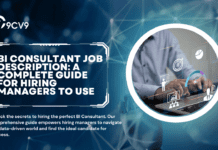





![Writing A Good CV [6 Tips To Improve Your CV] 6 Tips To Improve Your CV](https://blog.9cv9.com/wp-content/uploads/2020/06/2020-06-02-2-100x70.png)


